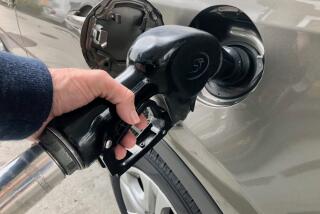Leaded Gas Falls Below $1--a First Since Gulf Crisis
- Share via
Cheering--and surprising--consumers and economists alike, gasoline prices at some Southland pumps have dropped below $1 for the first time since the beginning of the Persian Gulf crisis.
“I think it’s great, because this truck uses a lot of gas,” said Arthur Respicio, a self-employed repairman, as he filled the tank of his 1983 Toyota truck Tuesday with unleaded gas at a Shell station in the Koreatown section of Los Angeles. The station offered regular leaded gasoline for 99 cents a gallon.
According to the authoritative Lundberg Letter, of the almost 1,600 service stations most recently surveyed in Greater Los Angeles, 111 were selling regular leaded gasoline at self-service pumps for under $1. That included “a smattering” of major-brand stations, as well as independents, publisher Trilby Lundberg said.
Prices are falling nationwide, although they are lower in Southern California than in other regions.
In its latest survey of prices, the American Automobile Assn. reported Tuesday that the nationwide average price of self-serve regular unleaded gasoline fell 4.2 cents in the last week, to $1.183, the lowest since Aug. 3, the day after Iraq invaded Kuwait. According to the latest Lundberg survey, the average price of self-serve regular unleaded gas in Southern California was $1.146.
And with the current surplus of oil, many petroleum-market experts expected gasoline prices to remain low, or even drop more--an especially welcome turn, with the economy mired in a slump.
“It is great medicine for an economy in recession,” said Philip K. Verleger Jr., an economist who specializes in energy at the Institute for International Economics, a Washington think tank.
While some experts cautioned that lower prices could spur consumption, increasing both U.S. dependence on foreign energy resources and air pollution, others saw only good news in the price drop.
“I really think it’s better to have lower prices than we had later last year, because energy is a big cost in our economy,” said Ray Gibson, senior associate for Carl H. Pforzheimer & Co., a New York-based brokerage firm that specializes in oil.
“It’s not only people running back and forth to work,” Gibson said, “but it goes into the cost of everything you move by truck and rail. It’s a big item. And I think gasoline marketers (themselves) generally prefer stable and reasonable prices. . . . They really can be zapped by price volatility.”
Consumers interviewed Tuesday thought it only appropriate that prices were falling.
“I don’t know why the prices went up in the first place,” said Los Angeles resident Robert Randall as he pumped gasoline at an Atlantic Richfield station in the Westlake section of Los Angeles. “We have plenty of gas in this country. There’s no shortage.”
Randall said he drives only when necessary and--despite the drop in price--would not consume more gas. Regular unleaded gas was 99 cents a gallon at the station where he filled up.
Randy Waller, a Los Angeles process server, said he figured that the price fluctuations were a simple matter of supply and demand.
“This is part of the ebb and flow of the market,” he said, filling up at the Koreatown Shell station. “When there’s lots of gas--a glut--the price is cheaper. When the spigot tightens, gas prices go up.”
For the moment, the spigot is open, even as demand for oil has slackened worldwide. The Paris-based International Energy Agency said Tuesday that despite OPEC production cutbacks in January, oil was still clogging storage facilities. The IEA said there were 20 million more barrels in surplus stocks last month than in December.
“There’s still plenty of crude out there for the present demand,” said Thomas P. Blakeslee, an energy analyst with Pegasus Econometric Group, a Hoboken, N.J., commodity consulting firm. “And the refinery runs are beginning to increase. So you’re seeing plenty of product out there for the present demand. That’s why you’ve seen prices come down considerably over the last couple of weeks.”
The IEA said oil consumption in the United States dropped almost 10% in December, compared to a year earlier.
Blakeslee and other analysts attributed the slack demand to recession jitters, warmer temperatures around the nation and consumer indignation that prices had jumped in the months before fighting broke out.
Even experts, however, were puzzled by some of the moves in retail fuel prices.
“Gasoline has gone down and diesel has gone up. I’ve never seen anything like it,” said Stephen R. Shelton, executive director of the Southern California Service Station Assn., a retailer trade group.
“My personal opinion is that the oil companies have pushed the prices down on gasoline,” he said. “The public is very price conscious on gasoline, but no one monitors the prices of diesel and jet fuel and the other products, so I think the oil companies want to avoid the bad publicity and public reaction of having embarrassingly high profits while a war is going on.”
Economists have long been mixed on whether low gasoline prices are good or bad for the U.S. economy.
“Many people believe that a high level of oil imports constitutes a threat to the nation,” said Verleger. But he questioned the wisdom of artificially keeping prices high. “The economy benefits from free trade, whether the free trade be in automobiles, VCRs or petroleum,” Verleger said.
Blakeslee concurred that the low prices pose an economic dilemma.
“Oil prices we’re seeing now will prevent further investment in alternative sources of energy,” he said. “But at the same time, these lower oil prices might help us pull out of a recession quicker.”
Still, said Blakeslee, if such low prices persist, they will only build consumption and slow development of new energy policies to lower U.S. dependence on foreign oil. “Which is a scary thought,” he added, “seeing our men and women over there fighting for it now.”
More to Read
Inside the business of entertainment
The Wide Shot brings you news, analysis and insights on everything from streaming wars to production — and what it all means for the future.
You may occasionally receive promotional content from the Los Angeles Times.










